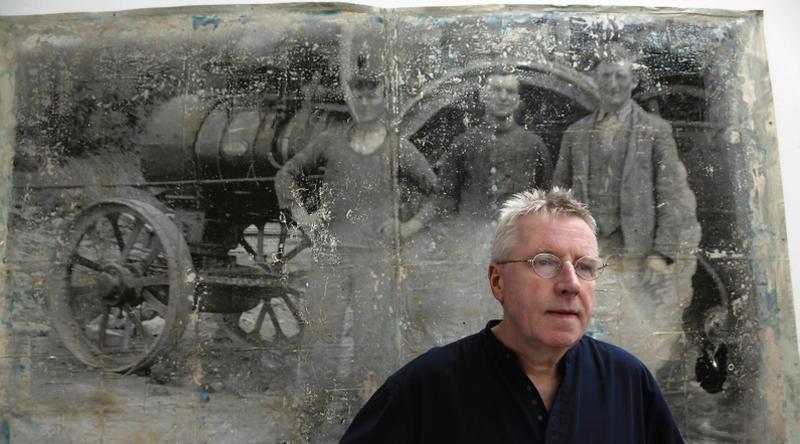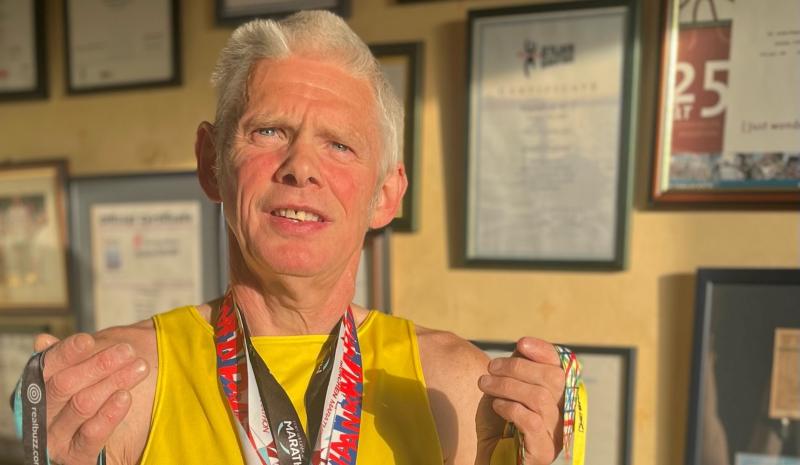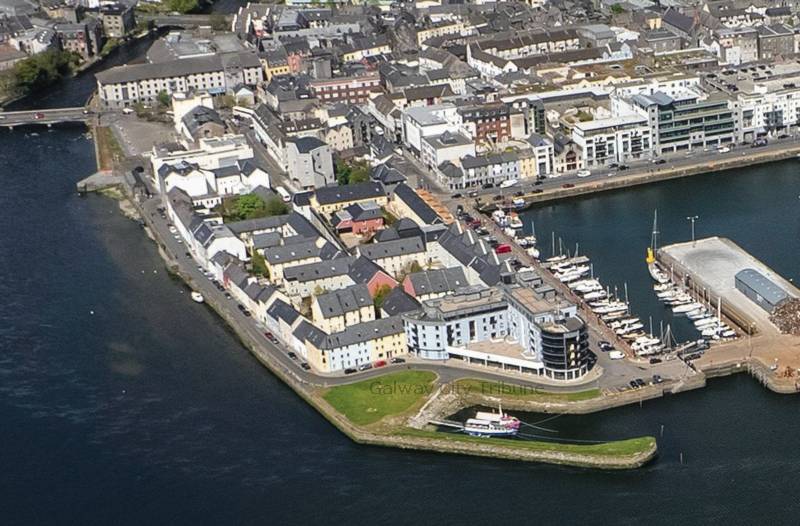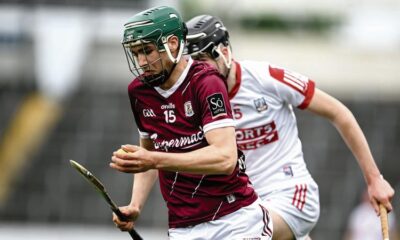Featured
How history has different perspectives – and truths

Lifestyle – Judy Murphy meets artist Hughie O’Donoghue whose new exhibition looks at 1916 and WWI in unique way
Truth is very much a subjective thing – it’s very difficult to define it,” observes artist Hughie O’Donoghue, whose new exhibition, One Hundred Years and Four Quarters, looks back at the events of 1916 in a unique and moving way.
One Hundred Years and Four Quarters, created for Galway International Arts Festival is a show that draws on Hughie’s own family history to reflect the experience of many Irish families. It’s housed in the former printworks of the Connacht Tribune, an industrial, airy space that does justice to these massive paintings and sculptures.
When it comes to the major events of 1916 – World War I and the Easter Rising – Hughie points out that there are no simple historic truths and that complexity is reflected in his work.
“Memory is how we feel about things, rather than the facts,” he says, explaining that people have their own versions of truth, based on personal memory.
He gives Akira Kurosawa’s 1950 film Rashômon as an example.
“There’s a murder that’s witnessed by four people, all of whom give contradictory evidence about what happened.”
So much for history. Still, there are certain definite facts that Manchester-born Hughie took as starting points for this exhibition.
“I wanted the four cardinal events of 1916,” he explains how this exhibition evolved.
He’s had a long relationship with Galway Arts Festival and that organisation contacted him in 2014 about creating a series of work to explore national identity in Ireland via the Easter Rising and the experience of Irish people in World War I.
The Rising and the Battle of the Somme occurred just a few weeks apart, and as Hughie points out, “larger numbers of Irishmen were involved in the Somme than in the Rising, which is something that was forgotten for many years”.
These contradictory aspects of the Irish story form the first two parts of this exhibition’s four-pronged approach.
Another element is the Battle of Jutland, which “was the most significant battle of 1916”, he says.
In this naval battle, massive ships were firing at each other from such colossal distances, that they were like shadows. Many of the mighty vessels blew up in seconds, taking thousands of lives with them.
Jutland was a pivotal battle which helped turn the war in Britain’s favour but nobody realised that at the time, he explains.
“For a long time after, people didn’t know who had won. Britain lost more men than Germany, but won the battle.”
The final component of One Hundred Years and Four Quarters are those people whose lives “these events passed by” he says about World War I and the Easter Rising.
Those people included his mother’s family in North Mayo’s Erris peninsula, who “eked out a living in very poor land”.
There was a mini-famine in Erris in 1916, he adds. This “harsh and remote” area of Mayo, where Hughie spent much of his childhood is now home to the artist and his wife Clare. It has just one road that leads to Ballina and the larger world outside – back then that was a track.
And, as we walk around the gallery, this quietly-spoken man who graduated from London’s Goldsmiths College in 1982 with MA in Fine Art gives the background to each piece. It’s a fascinating insight into his method and the humanity he brings to his work.
For more, read this week’s Connacht Tribune.
Connacht Tribune
West has lower cancer survival rates than rest

Significant state investment is required to address ‘shocking’ inequalities that leave cancer patients in the West at greater risk of succumbing to the disease.
A meeting of Regional Health Forum West heard that survival rates for breast, lung and colorectal cancers than the national average, and with the most deprived quintile of the population, the West’s residents faced poorer outcomes from a cancer diagnosis.
For breast cancer patients, the five-year survival rate was 80% in the West versus 85% nationally; for lung cancer patients it was 16.7% in the west against a 19.5% national survival rate; and in the West’s colorectal cancer patients, there was a 62.6% survival rate where the national average was 63.1%.
These startling statistics were provided in answer to a question from Ballinasloe-based Cllr Evelyn Parsons (Ind) who said it was yet another reminder that cancer treatment infrastructure in the West was in dire need of improvement.
“The situation is pretty stark. In the Western Regional Health Forum area, we have the highest incidence of deprivation and the highest health inequalities because of that – we have the highest incidences of cancer nationally because of that,” said Cllr Parsons, who is also a general practitioner.
In details provided by CEO of Saolta Health Care Group, which operates Galway’s hospitals, it was stated that a number of factors were impacting on patient outcomes.
Get the full story in this week’s Connacht Tribune, on sale in shops now, or you can download the digital edition from www.connachttribune.ie. You can also download our Connacht Tribune App from Apple’s App Store or get the Android Version from Google Play.
Connacht Tribune
Marathon Man plans to call a halt – but not before he hits 160 races

On the eve of completing his 150th marathon, an odyssey that has taken him across 53 countries, Loughrea’s Marathon Man has announced that he is planning to hang up his running shoes.
But not before Jarlath Fitzgerald completes another ten races, making it 160 marathons on the occasion of his 60th birthday.
“I want to draw the line in 2026. I turn 57 in October and when I reach 60 it’s the finishing line. The longer races are taking it out of me. I did 20 miles there two weeks ago and didn’t feel good. It’s getting harder,” he reveals.
“I’ve arthritis in both hips and there’s wear and tear in the knees.”
We speak as he is about to head out for a run before his shift in Supervalu Loughrea. Despite his physical complaints, he still clocks up 30 miles every second week and generally runs four days a week.
Jarlath receives injections to his left hip to keep the pain at bay while running on the road.
To give his joints a break, during the winter he runs cross country and often does a five-mile trek around Kylebrack Wood.
He is planning on running his 150th marathon in Cork on June 4, where a group of 20 made up of work colleagues, friends and running mates from Loughrea Athletics Club will join him.
Some are doing the 10k, others are doing the half marathon, but all will be there on the finishing line to cheer him on in the phenomenal achievement.
Get the full story in this week’s Connacht Tribune, on sale in shops now, or you can download the digital edition from www.connachttribune.ie. You can also download our Connacht Tribune App from Apple’s App Store or get the Android Version from Google Play.
CITY TRIBUNE
Galway ‘masterplan’ needed to tackle housing and transport crises

From the Galway City Tribune – An impassioned plea for a ‘masterplan’ that would guide Galway City into the future has been made in the Dáil. Galway West TD Catherine Connolly stated this week that there needed to be an all-inclusive approach with “vision and leadership” in order to build a sustainable city.
Deputy Connolly spoke at length at the crisis surrounding traffic and housing in Galway city and said that not all of the blame could be laid at the door of the local authority.
She said that her preference would be the provision of light rail as the main form of public transport, but that this would have to be driven by the government.
“I sat on the local council for 17 years and despaired at all of the solutions going down one road, metaphorically and literally. In 2005 we put Park & Ride into the development plan, but that has not been rolled out. A 2016 transport strategy was outdated at the time and still has not been updated.
“Due to the housing crisis in the city, a task force was set up in 2019. Not a single report or analysis has been published on the cause of the crisis,” added Deputy Connolly.
She then referred to a report from the Land Development Agency (LDA) that identified lands suitable for the provision of housing. But she said that two-thirds of these had significant problems and a large portion was in Merlin Park University Hospital which, she said, would never have housing built on it.
In response, Minister Simon Harris spoke of the continuing job investment in the city and also in higher education, which is his portfolio.
But turning his attention to traffic congestion, he accepted that there were “real issues” when it came to transport, mobility and accessibility around Galway.
“We share the view that we need a Park & Ride facility and I understand there are also Bus Connects plans.
“I also suggest that the City Council reflect on her comments. I am proud to be in a Government that is providing unparalleled levels of investment to local authorities and unparalleled opportunities for local authorities to draw down,” he said.
Then Minister Harris referred to the controversial Galway City Outer Ring Road which he said was “struck down by An Bord Pleanála”, despite a lot of energy having been put into that project.
However, Deputy Connolly picked up on this and pointed out that An Bord Pleanála did not say ‘No’ to the ring road.
“The High Court said ‘No’ to the ring road because An Bord Pleanála acknowledged it failed utterly to consider climate change and our climate change obligations.
“That tells us something about An Bord Pleanála and the management that submitted such a plan.”
In the end, Minister Harris agreed that there needed to be a masterplan for Galway City.
“I suggest it is for the local authority to come up with a vision and then work with the Government to try to fund and implement that.”












